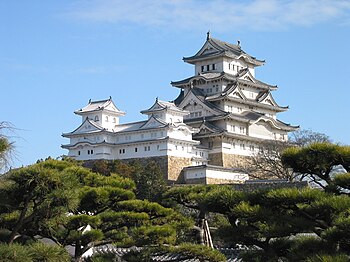List of National Treasures of Japan (Castles)
The Sengoku period , also the time of the warring states , was an eventful period in Japanese history, which was almost uninterruptedly characterized by military conflicts. Feudal rulers ( daimyō ) such as Oda Nobunaga , Toyotomi Hideyoshi or Tokugawa Ieyasu fought each other to unite Japan. In the course of this period of time, many fortresses and castles were built due to the ongoing conflict. The archetype of a Japanese castle therefore comes from the subsequent periods, the Azuchi Momoyama (1573–1603) and the early Edo period .
A new age of castle building began when Prince Nobunaga built Azuchi Castle from 1576 to 1579 . Earlier fortifications from the Kamakura (1185–1333) and Muromachi (1336–1573) periods were simple and expansive constructions. This is not the case with Azuchi Castle, which, with its splendid decorations and a height of seven floors, became the model for castle construction at that time. This castle also represented a change in the function of castles: castles were no longer just fortresses and military garrisons, but the center of political, cultural and economic events. These new castles now served the feudal lords as residences for the entire family and the most loyal followers . These castles were built of wood and mortar on a stone foundation. In general, which was Tenshu , the Donjon or keep , built at the highest point and interlocking structures such as forecourts , ramparts and moats surrounding it. Residential buildings were usually in the outer bailey. The daimyō stayed mostly in the citadel .
In the almost 20 years between 1596 and 1615 alone, 100 important castles were built. The construction of castles peaked between 1600 and 1615. In 1600 Tokugawa Ieyasu had defeated the Toyotomi clan at the Battle of Sekigahara and completely wiped out their troops until the siege of Osaka (1615). Japan was united and the Edo period began. As a result, the Tokugawa shogunate limited the number of castles to one per province and in 1620 prohibited the construction of new castles entirely. At the time of the Meiji restoration , at the end of the 19th century, the castles were no longer used and they were neglected. As a symbol of the rulers of yesteryear, some castles were dismantled and even sold as firewood. Others have been destroyed by conflagrations, earthquakes, and cyclones. Only 12 castles still have their original keep.
Since 1897, designated “ material cultural goods ” can also be elevated to national treasures in Japan . The definition and criteria for a national treasure have changed over time. All of the castles listed here comply with the current provisions of the Cultural Property Protection Act , which has been in force since June 9, 1951. The appointment to the national treasure occurs because of the "particularly high historical or artistic value" and by the Minister of Education . The list includes four castles with eight national treasures built from the Momoyama period to the early Edo period . The number of national treasures is de facto higher because individual parts of the building are grouped together under one registration number. The list includes defense towers (donjon), (guard) towers (yagura) and connecting passages.
Key figures
The eight national treasures are spread across four castles: Himeji Castle has five, Hikone , Inuyama and Matsumoto castles one each. The castles can be divided into three types of castles according to their location: high-altitude castles ( 山城 , yamajiro ), if they stand on a natural scenic hill, low- rise castles ( 平城 , hirajiro ) and moths ( 平 山城 , hirayamajiro ), if they are on one man-made hill stand.
The donjon can be designed in two ways: in the older "Bōrōgata" ( 望楼 型 ) or "Sōtōgata construction" ( 望楼 型 ). In the older design, a watchtower was placed on a residential building or a residential tower. The Sōtōgata construction consists of defensive towers that, like a pagoda, had a covered hipped roof on each floor. This type of construction can be found at Matsumoto Castle, which has an almost square foundation, with the floors tapering towards the top.
The donjon was rarely free and unconnected to other parts of the building. It is usually arranged with watchtowers ( yagura ) as a composite ensemble ( 複合 式 天 守 , Fukugōshiki Tenshu ) of a large ( 大 天 守 , Daitenshu ) and a small tower ( 小 天 守 , Kotenshu ) and sometimes through a connecting passage ( 渡 櫓 , Watariyagura ) connected. If the towers are directly connected by a corridor, one speaks of ( 連結 式 天 守 , Renketsushiki Tenshu ). A typical donjon had between three and seven externally recognizable floors. As in European construction, the number of internal storeys can differ from the number of storeys.
Legend
The columns in the table below can be sorted with the exception of the image column.
- Designation : Designation of the structure according to the database for national cultural assets.
- Castle : Name of the castle.
- Type of construction : Type of construction with general comments including the number of floors / storeys.
- Period : Period of construction, sorted by year. If no exact date is known, the year in which the period begins is given here.
- Location : city, prefecture and geographic coordinates of the building, sorted by prefectural name.
- Image : illustration of the structure; the relevant building structure is indicated by a blue frame.
National treasures
| designation | Castle | design type | Time period | Location | image |
|---|---|---|---|---|---|
| Donjon ( 天 守 , Tenshu ) | Hikone Castle | Donjon, three floors with vaulted cellars and entrance hall. The roof is covered in the Hongawarabuki style ( 本 瓦 葺 ): flat, concave tiles are combined with semi-cylindrical convex tiles. | Momoyama period , 1606 |
Hikone , Shiga Prefecture 35 ° 16 ′ 35.2 ″ N , 136 ° 15 ′ 6.6 ″ E |

|
| Extension tower ( 附 櫓 , Tsukeyagura ) and Tamon tower ( 多 聞 櫓 , Tamonyagura ) | Hikone Castle | single-storey watchtowers , Hongawarabuki roof. | Momoyama period , 1606 |
Hikone , Shiga Prefecture 35 ° 16 ′ 35.7 ″ N , 136 ° 15 ′ 6.7 ″ E |

|
| Great Donjon ( 大 天 守 , Daitenshu ) | Himeji Castle | Donjon, five storeys / six storeys, connected to the ni corridor to the west, to the i corridor to the north. | Momoyama period , 1608 |
Himeji , Hyogo Prefecture 34 ° 50 ′ 21.7 ″ N , 134 ° 41 ′ 38.7 ″ E |

|
| Northwest small tower ( 乾 小 天 守 , Inui Kotenshu ) | Himeji Castle | Donjon with three floors, connected in the east with the ro-corridor, in the south with the ha-corridor. | Momoyama period , around 1609 |
Himeji , Hyogo Prefecture 34 ° 50 ′ 22.6 ″ N , 134 ° 41 ′ 37.7 ″ E |
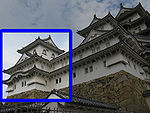
|
| Small western tower ( 西 小 天 守 , Nishi kotenshu ) | Himeji Castle | Donjon, three floors, connected to the ni corridor to the east and the ha corridor to the north. | Momoyama period , around 1609 |
Himeji , Hyogo Prefecture 34 ° 50 ′ 21.8 ″ N , 134 ° 41 ′ 37.6 ″ E |

|
| Eastern small tower ( 東 小 天 守 , Higashi kotenshu ) | Himeji Castle | Donjon three floors, connected on the west side with the ro-corridor, in the south with the i-corridor. | Momoyama period , around 1609 |
Himeji , Hyogo Prefecture 34 ° 50 ′ 22.4 ″ N , 134 ° 41 ′ 39.1 ″ E |
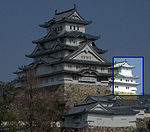
|
| Connecting corridors I, Ro, Ha, Ni ( イ, ロ, ハ, ニ の 渡 櫓 , i, ro, ha, ni no watariyagura ) | Himeji Castle |
Connecting corridor, two floors. I-corridor: between the large tower and the eastern, small tower, height 9.03 m on a 8.88 m high stone wall, |
Momoyama period , around 1609 |
Himeji , Hyogo Prefecture 34 ° 50 ′ 22.1 ″ N , 134 ° 41 ′ 38.2 ″ E |
 
|
| Donjon ( 天 守 , Tenshu ) | Inuyama Castle | Donjon, three floors, height approx. 25 m, with single-storey watchtowers. | Momoyama period , 1601 |
Inuyama , Aichi Prefecture 35 ° 23 ′ 18 ″ N , 136 ° 56 ′ 21 ″ E |

|
| Donjon ( 天 守 , Tenshu ) | Matsumoto Castle | Donjon, five floors. | Tenshu: early Edo period , early Genna era |
Matsumoto , Nagano Prefecture 36 ° 14 ′ 19 ″ N , 137 ° 58 ′ 7.9 ″ E |
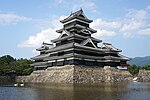
|
| Small, northwest tower ( 乾 小 天 守 , Inui Kotenshu ) | Matsumoto Castle | Second defense tower, three floors. | Momoyama period , Bunroku period (1592–1596) |
Matsumoto , Nagano Prefecture 36 ° 14 ′ 19.7 ″ N , 137 ° 58 ′ 7.8 ″ E |

|
| Connecting passage ( 渡 櫓 , Watari yagura ) | Matsumoto Castle | Connecting corridor, two floors. | early Edo period , around early Genna era |
Matsumoto , Nagano Prefecture 36 ° 14 ′ 19.4 ″ N , 137 ° 58 ′ 7.8 ″ E |
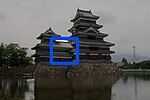
|
| Southeast connecting tower ( 辰 巳 附 櫓 , Tatsumi tsukeyagura ) | Matsumoto Castle | Connection tower, two floors. | early Edo period , Kan'ei era (1624–1643) |
Matsumoto , Nagano Prefecture 36 ° 14 ′ 18.8 ″ N , 137 ° 58 ′ 8.3 ″ E |

|
| Moon Show Tower ( 月 見 櫓 , Tsukimi yagura ) | Matsumoto Castle | Connection tower, one floor | early Edo period , Kan'ei era (1624–1643) |
Matsumoto , Nagano Prefecture 36 ° 14 ′ 18.8 ″ N , 137 ° 58 ′ 8.6 ″ E |

|
See also
literature
- Jean-Sébastien Cluzel: Architecture éternelle du Japon - De l'histoire aux mythes . Editions Faton, 2008, ISBN 978-2-87844-107-9 ( limited preview in Google Book Search).
- William Howard Coaldrake: Architecture and authority in Japan . Routledge, 1996, ISBN 0-415-05754-X ( limited preview in Google Book Search).
- William E. Deal: Handbook to life in medieval and early modern Japan . Oxford University Press, New York 2007, ISBN 0-19-533126-5 ( limited preview in Google Book Search).
- Kazuo Nishi, Kazuo Hozumi: What is ja architecture? Kodansha International, 1996, ISBN 4-7700-1992-0 ( limited preview in Google Book Search).
- Peter Dennis, Stephen Turnbull: Japanese castles 1540-1640 . Osprey Publishing, 2003, ISBN 1-84176-429-9 ( limited preview in Google Book Search).
Web links
Individual evidence
- ^ Cultural Properties for Future Generations. (PDF; 1.1 MB) Office for Cultural Affairs , March 2011, archived from the original on August 13, 2011 ; Retrieved January 26, 2012 .
- ↑ a b 国 指定 文化 財 デ ー タ ベ ー ス (database of national cultural assets). Office for Cultural Affairs, November 1, 2008, accessed April 16, 2009 (Japanese).
- ↑ bourougatatenshu. JAANUS architecture database, accessed January 26, 2011 .
- ↑ soutougatatenshu. JAANUS architecture database, accessed January 26, 2011 .
- ↑ Main Keep. Jcastle - Guide to Japanese Castles, 2011, archived from the original on December 18, 2012 ; accessed on January 26, 2011 (English).
- ↑ watariyagura. JAANUS architecture database, accessed January 26, 2011 .
- ↑ renketsu tenshu. JAANUS architecture database, accessed November 9, 2009 .
- ↑ 彦 根 城 (Hikone Castle). jcastle.info, archived from the original on February 16, 2009 ; Retrieved January 26, 2011 (Japanese).
- ↑ hongawarabuki. JAANUS architecture database, accessed January 26, 2011 .
- ↑ fukugou tenshu. JAANUS architecture database, accessed on January 28, 2011 (English).
- ↑ 姫 路 城 大 天 守 (Great Keep of Himeji Castle). Himeji , accessed January 26, 2012 (Japanese).
- ↑ 姫 路 城 乾 小 天 守 (Northwestern, small tower of Himeji Castle). Himeji City, Retrieved January 26, 2011 (Japanese).
- ↑ 姫 路 城西 小 天 守 (Small western tower of Himeji Castle). Himeji City, Retrieved January 25, 2011 (Japanese).
- ↑ 姫 路 城東 小 天 守 (Himeji Castle East Small Tower). Himeji City, Retrieved November 17, 2009 (Japanese).
- ↑ 姫 路 城 イ ・ ロ ・ ハ ・ ニ の 渡 櫓 附 台 所 1 棟 (Himeji Castle I, Ro, Ha, Ni-corridors and one attached kitchen). Himeji , accessed January 23, 2011 (Japanese).
- ↑ Inuyama Castle. Japanese National Tourism Organization, accessed January 22, 2011 .
Remarks
- ↑ a b c The structures and parts that belong to Hikone Castle are registered under one number and only as a national treasure. This national treasure is listed here in two entries for better readability.
- ↑ a b c d e f The structures that belong to the national treasure of Matsumoto Castle are listed as a national treasure under a registration number. For the sake of clarity, this national treasure is divided into five parts here.
- ↑ a b c d e The four connecting corridors of Himeji Castle are according to the Iroha system with "I", "Ro", "Ha", "Ni", correspondingly in German with "A", "B", "C" , Labeled "D".
- ↑ The kitchen also belongs to this part of the national treasure.
